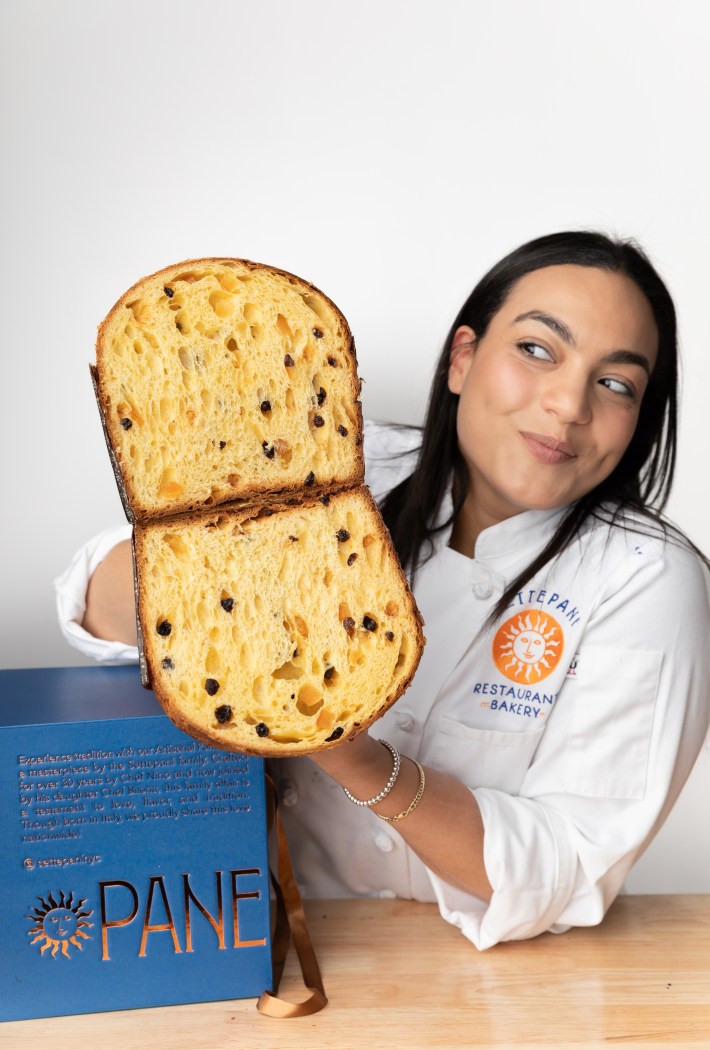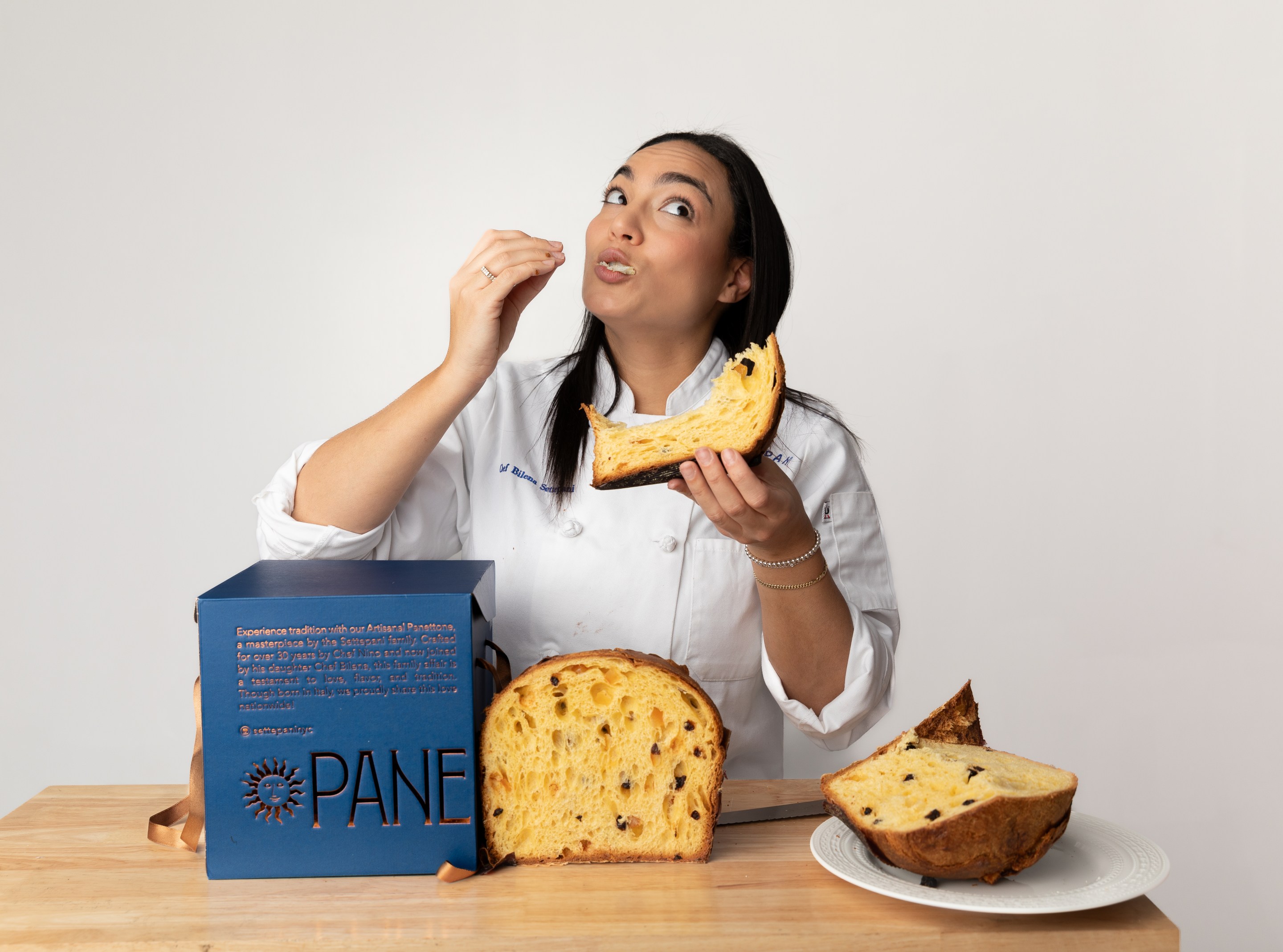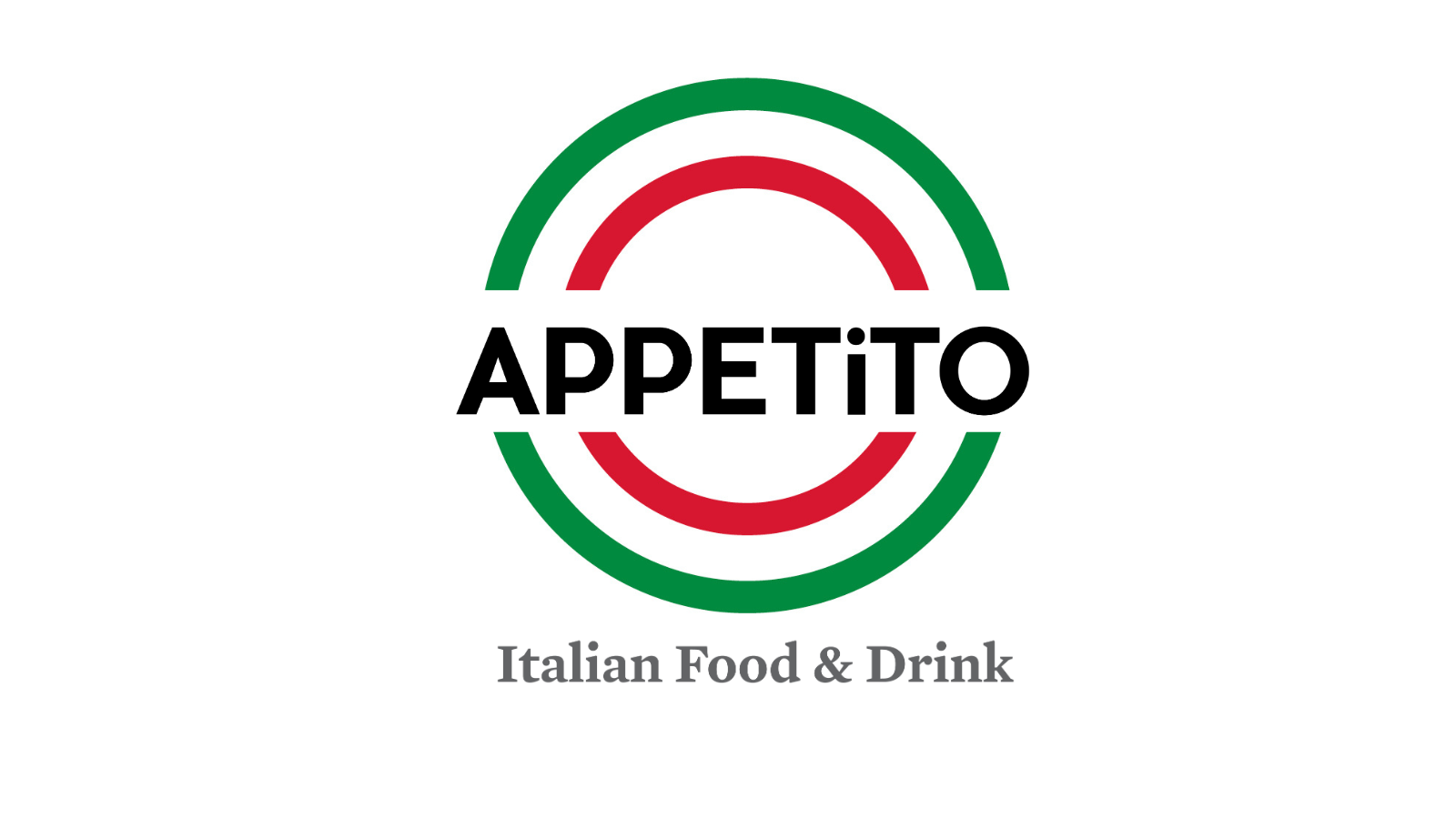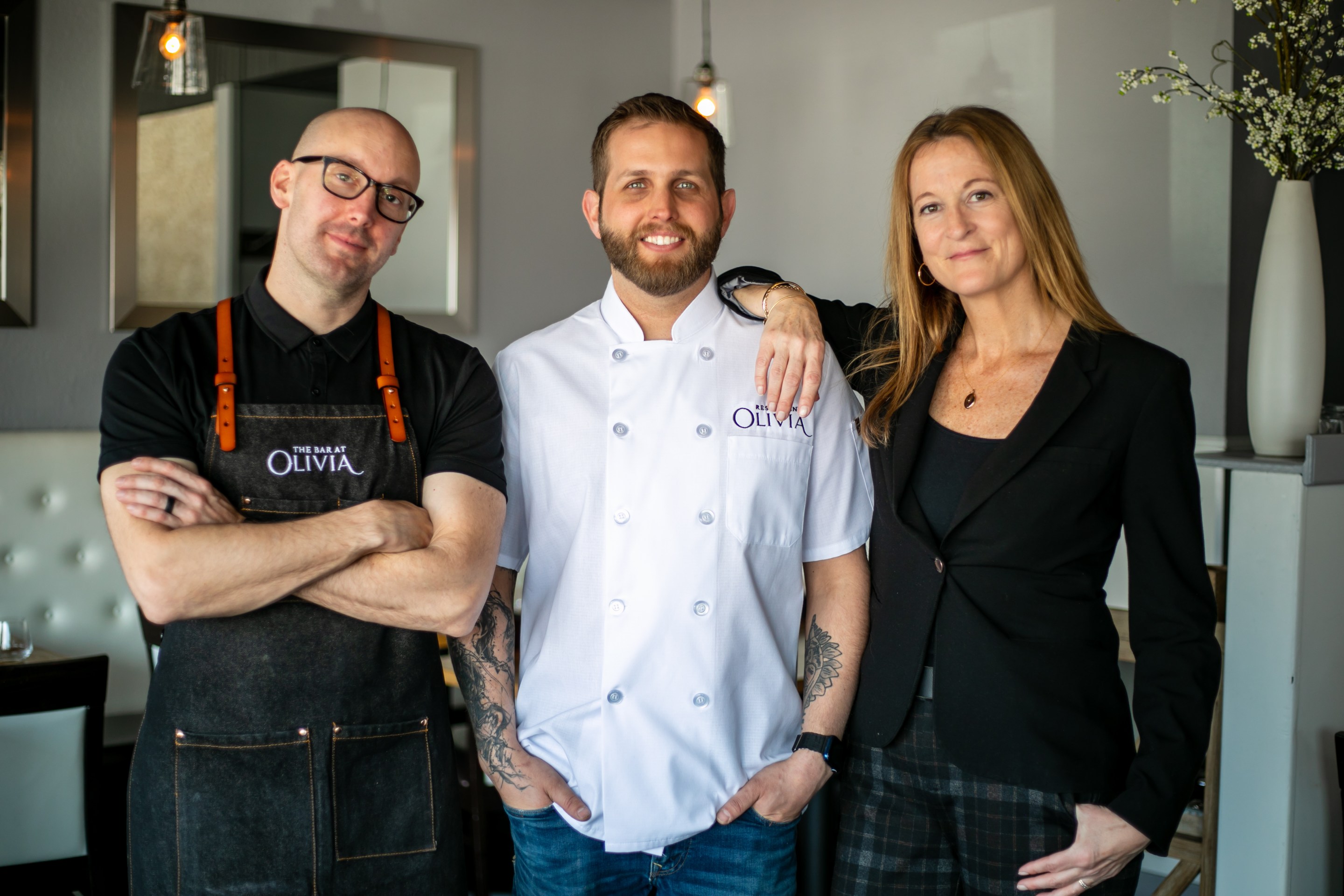Bilena Settepani is the perfect person to offer a panettone primer, a self-styled “Panettone Princess” whose passion for the sweet bread is inspiring and infectious. With colorful panettone boxes stacked in shops and of course in Italian markets during the Christmas season, we’ve asked Settepani to discuss the basics of panettone, as well as her family’s popular brand of artisanal panettone, made by her Sicilian father, Nino, and more recently, herself.
Bilena says she started contributing to the family’s panettone output as a baker during the pandemic, when Nino was trying to balance running Settepani Restaurant in Harlem and Settepani Bakery in Williamsburg. Bilena’s Ethiopian mother, Leah Abraham, who has always been an integral part of the family business, was going through chemotherapy treatment, making things even more challenging. Then the family matriarch, Filippa Settepani, Nino’s mother and a constant presence at the retail bakery in Greenpoint, Brooklyn, passed away.
Bilena stepped in to join the family business and has quickly become a respected baker, earning recognition this past summer as one of “the best bakers in the world” at a conference in Milan, with an award bestowed by one of her culinary idols, legendary pastry chef Iginio Massari. Bilena says that when she first got the call asking her to attend, she “thought it was a scam.”
Bilena—who, I should point out, is a contributor to Appetito, and an increasingly followed Instagram personality—earned the distinction in recognition of her innovative work, which has included creating a Nutella panettone that has become one of Settepani’s best sellers.

While she demurs about siding with one of the several origin stories of the inventions of panettone, which is traced to Milan in the 15th century, she knows just about anything else you could ask her about panettone. Here is her panettone primer, along with some anecdotes about Settepani’s popular panettone, which is available at the family restaurant or bakery or by mail order at Goldbelly.
How to Say Panettone
It’s pronounced pan-eh-toe-neh, with the emphasis on the third syllable.
Panettone Starts With a Starter Dough
Remember those sourdough starters that everyone seemed to have during the pandemic, when feeding flour and water into the starter helped alleviate some of the drudgery of being socially isolated? Panettone starts in a similar way, with a natural yeast known in Italian as “lievito madre.”
Bilena explains that her family’s lievito madre started in the 1980s, when her father Nino and his family purchased a bakery in Greenwich Village, not long after immigrating to New York from Italy. Though he’d intended to go into banking, Nino joined the bakery and began making Italian pastries, and eventually, panettone. Now, he and Bilena feed the lievito madre “every day,” she says, and take care of it “like a baby,” moving it to temperature-controlled areas in extreme heat or cold.
How to Make Panettone
To make a new mix, a part of the lievito madre is combined with flour and water for a first mix. About 12 hours later, after the dough has expanded, the process is repeated for a second mix, which then adds ingredients such as chocolate or the traditional candied fruit and raisins to egg yolk, sugar, vanilla, and honey.
The yeast leavening process and the mixing of the dough in a twin-arms mixer creates the airy texture that has made panettone a beloved sweet treat around the world (more on that later). But it does require a lot of care—Bilena says that she has set up a camera in the bakery to keep an eye on the dough when she’s not there, and that she typically arrives to make the second mixture by 5:45 a.m.
From there, the dough rests a bit more, is shaped and then placed in a mold, where it rises even more before it is baked for about 45 minutes. Then, Bilena explains, the dome-shaped panettone is flipped upside down so it doesn’t collapse on itself—like a soufflé, she says—and rests for a minimum of eight hours before it can be packaged.
Why Panettone Can Be Expensive
Processes like Bilena’s help explain why artisanal panettone can be expensive. A large panettone, such as Settepani’s Traditional Milanese Panettone, weighs about 2 lbs. and can cost in the $60-$80 range, comparable to other artisanal brands. The quality of ingredients is another factor, with higher-end bakeries typically using thoughtfully sourced butter, flour, vanilla, chocolate, and fruits.
Industrial-made panettone cost less than half of an artisanal panettone, but tend to be made with inferior ingredients. These less-expensive versions will likely be denser and will lose their freshness within days of being opened, whereas well-made artisanal panettone can last for three weeks or longer if wrapped in plastic after opening.
For those who want an entry-level panettone, the Italian brand Motta, credited with one of the first industrial production lines for the bread in the 1930’s, still exists today, with panettone that retails for as little as $11.
Panettone Can be Made Year-Round
Panettone is associated with Christmas in large part because of its origin stories, which all revolve around it being created during the beloved holiday.
The most common legend has it that the chef of nobleman Ludovico Sforza (also known as Ludovico Il Moro) invented it after burning the dessert he’d prepared for a Christmas Eve banquet and used starter dough made by a kitchen boy named Toni to make a leavened dough mixed with flour, eggs, sugar, raisins, and candied fruit. The nobleman liked the result and dubbed it “Pan de Toni,” or Toni’s bread. (Skeptics note that the word panettone derives from the word panetto, or small loaf of bread; the suffix changes the meaning to big.)
Today, some bakeries make panettone year-round, and a dove-shaped variation, Colomba bread, has become an Easter tradition. Settepani is one of the only U.S. bakeries that makes panettone year-round, in part because its panettone French toast is a top-seller at brunch at their Harlem restaurant. They also make a red velvet panettone with a side of cream cheese frosting sold leading up to Valentine’s Day. They’ve even made panettone with M&M’s, a favorite with kids, Bilena says. And then there’s the Nutella panettone.

Panettone purists consider candied fruits, raisins, and perhaps chocolate chips as essential ingredients, but it’s no wonder why Bilena’s own father nearly revolted when she tried to add the hazelnut spread to Settepani’s panettone. “One day when he walked away, I threw Nutella into our mix,” Bilena recalls with a laugh. “My dad was like, ‘No, there’s fat in there! You’d have to balance it with the butter. This isn’t just a game.’ I was like, ‘Dad, it’s gonna be delicious.’ So guess what? It was delicious.” Settepani’s Nutella panettone became a top-seller and, she says, a hit with consumers who didn’t even know what panettone is. They’d buy it and say, “Oh wow, that’s a big muffin,” she says.
Panettone’s International Reach
Not only has panettone’s popularity spread beyond Italy, it’s even surpassed it, becoming more popular in South America than anywhere else. As Bilena points out, the largest panettone brand is Brazil’s Bauducco, which was founded in the 1950s by an Italian immigrant. According to Smithsonian magazine, it produces 200,000 tons of panettone each year, exporting it to 50 countries from six industrial bakeries, including one in Miami.
Italian immigrants to Argentina and Peru helped popularize panettone throughout South America. Antonio D’Onofrio opened a bakery in Lima in the early 20th century, growing his panettone brand thanks to an audience of immigrants from Lombardy and Piedmont. Today, D’Onofrio is another panettone giant and is a subsidiary of Nestlé.
The reach of panettone extends to Africa. Bilena explains that her great-grandfather on her mother’s side was Eritrean but spoke Italian and became a businessman who imported Italian products to Ethiopia, including panettone. Now, she says, Ethiopians are the top consumers of panettone in Africa, which is reflected in sales of Settepani panettone today. “We sell a lot of panettone for Christmas, but then for Ethiopian Christmas, the Epiphany, which falls on January 7, we sell almost the same amount of panettone to the Washington DC, DMV area.”
How to Enjoy Panettone
No matter where in the world you’re eating it or what time of year it is, panettone is generally consumed as a dessert, though there are exceptions. Bilena notes that many, like her mother, eat it with morning coffee. Bilena adds that she prefers it as a dessert accompanying gelato, while she says that she regularly sees Italians consume panettone with liqueurs such as amaro, or with the sweet wine known as Vin Santo.
There is also a savory version, panettone gastronomico, sometimes called a sandwich tower, with fillings such as lox and cream cheese, or a play on a Caprese with mozzarella, basil, and tomato. (The panettone itself is made with much less sugar in this preparation.) Bilena says that Settepani has in the past produced a gastronomico with rosemary, olives, and olive oil, which she hopes to bring back as one of their flavors of the month in the near future.
In other words, anyone who ever equated panettone with run-of-the-mill fruit cake is about to be in for a big surprise.







